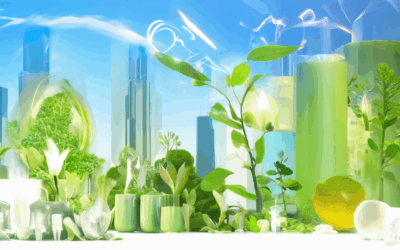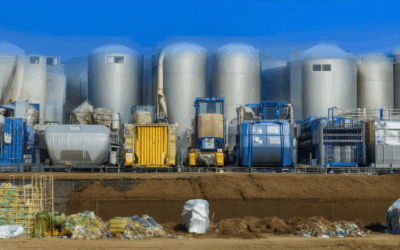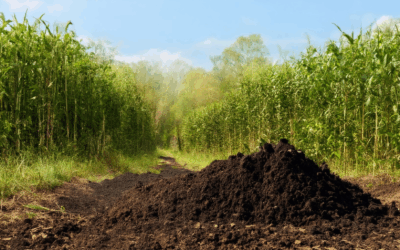The demand for sustainable farming practices has never been higher, with eco-friendly biochar practices emerging as a groundbreaking solution to enhance agricultural productivity while minimizing environmental impact. Biochar, a versatile material derived from organic waste through controlled pyrolysis, has gained significant attention for its ability to improve soil health, reduce greenhouse gas emissions, and promote biodiversity. As the biochar industry continues to evolve, farmers and environmental enthusiasts are increasingly recognizing its potential as a cornerstone of sustainable practices.
Key Takeaways
– Biochar Enhances Soil Health: Improves soil structure, boosts microbial activity, and increases water retention, making it ideal for sustainable farming.
– Effective Nutrient Absorption: Acts as a natural soil amendment, enhancing crop yields and nutrient uptake while reducing reliance on synthetic fertilizers.
– Supports Regenerative Farming: Serves as a viable alternative to chemical inputs, promoting eco-friendly and sustainable agricultural practices.
– Removes Heavy Metals: Effectively adsorbs harmful substances like lead and mercury from contaminated soils, aiding in environmental cleanup efforts.
– Reduces Greenhouse Gases: Helps mitigate pollution and contributes to carbon-negative strategies by storing carbon in the soil.
– Improves Water Quality: Can be used to filter impurities from water, offering a sustainable solution for clean drinking water.
– Sequesters Carbon Efficiently: Captures and stores carbon during production, supporting carbon capture and storage initiatives.
– Generates Renewable Energy: When activated, biochar can produce electricity, providing a clean and sustainable energy source.
– Enhances Building Materials: Adds strength and insulation properties to wood products, reducing the carbon footprint of construction materials.
– Improves Thermal Performance: Enhances the insulating properties of wooden structures, making buildings more energy-efficient.
By leveraging biochar’s versatile applications, users can contribute to sustainable practices, reduce their environmental impact, and explore innovative solutions across multiple industries.

Is Biochar Environmentally Friendly?
Biochar is generally considered environmentally friendly due to its ability to sequester carbon and improve soil health. Here’s a breakdown of its environmental benefits and considerations:
Environmental Benefits of Biochar
- Carbon Sequestration: Biochar can store significant amounts of carbon, potentially offsetting greenhouse gas emissions. Each ton of biochar can capture approximately 1.5 tons of CO2.
- Soil Improvement: As a soil amendment, biochar enhances soil fertility by adding essential nutrients and improving water retention, reducing the need for synthetic fertilizers and minimizing environmental contamination.
- Sustainable Material Use: Produced from organic waste or renewable biomass, biochar diverts materials from landfills and offers a sustainable alternative to conventional fuels.
Considerations for Environmental Friendliness
- Production Practices: The environmental impact of biochar depends on the sustainability of its production. Sustainable practices, such as using crop residues or tree trimmings, are crucial to minimize resource depletion.
- Energy Efficiency: High energy consumption during production can pose environmental challenges if not addressed through efficient processes.
- Regulatory Standards: Adherence to guidelines set by organizations like the International Biochar Initiative ensures responsible production and use, enhancing eco-friendliness.
Conclusion
Biochar can be environmentally friendly when produced and applied responsibly. Its ability to sequester carbon and promote sustainable agriculture makes it a promising tool for environmental stewardship. However, careful consideration of production methods and material sources is essential to maximize its positive impact.
Key Takeaways
- Biochar effectively captures carbon, contributing to climate goals.
- It enhances soil health, reducing reliance on harmful fertilizers.
- Responsible production practices are vital for maximizing environmental benefits.
Drawbacks of Biochar
- Potential Contamination: Biochar may contain harmful substances such as dioxins, furans, chlorinated hydrocarbons, and polycyclic aromatic hydrocarbons (PAHs). These contaminants can pose serious health risks if ingested or inhaled.
- Environmental Impact: While biochar is often praised for its carbon-sequestration benefits, improper production or application can lead to negative environmental effects. Excessive use might cause drainage issues or disrupt soil health if not managed properly.
- Handling and Disposal Challenges: Biochar can be heavy and difficult to handle, leading to potential messiness during application. Improper disposal can also contribute to environmental contamination.
- Regulatory Gaps: In some regions, the production and sale of biochar may lack sufficient regulation, increasing the risk of distributing contaminated products that could harm users or the environment.

The Most Efficient Way to Make Biochar
To make biochar efficiently, consider the following step-by-step guide:
- Choose Your Method : Decide between traditional pyrolysis, the mason jar method, or using metal containers. Each method suits different needs and resource availability.
- Select Materials : Opt for high-carbon materials like wood chips, sawdust, leaves, or branches. Avoid green, damp materials as they may not char properly.
- Prepare Containers :
- Pyrolysis Drum : Ideal for large batches, use a 55-gallon steel drum lined with insulation material.
- Mason Jar Method : Suitable for small-scale operations, use glass jars with lids.
- Metal Container : A large metal container with a lid works well for controlled charring.
- Set Up Airflow : Ensure adequate airflow to prevent combustion. Use fans or chimneys to circulate air, maintaining a controlled environment.
- Control Temperature : Use thermometers to monitor and regulate the temperature between 400°F to 750°F (200°C to 500°C), depending on desired biochar quality.
- Heat Slowly : For optimal nutrient retention, heat materials slowly. Avoid sudden increases in temperature to prevent burning.
- Ventilation : Open windows and ensure proper ventilation to prevent carbon monoxide buildup and manage smoke.
- Safety First : Keep fire extinguishers handy and follow safety protocols to mitigate risks associated with heat sources.
- Storage : Store biochar in airtight containers to preserve its effectiveness and prevent degradation.
- Consider Enhancements : Experiment with additives or specific wood types to customize biochar properties, enhancing its efficiency in your application.
By selecting the right method and attention to details, you can efficiently produce biochar for various uses, from energy to environmental benefits.

How Biochar Is an Environment-Friendly Alternative for Multiple Applications
Biochar, produced through a controlled pyrolysis process, offers a versatile and eco-friendly solution for various applications. Its unique properties make it highly effective in diverse contexts, from agriculture to energy production.
Applications in Agriculture
- Soil Health Improvement: Biochar enhances soil structure, increases microbial activity, and improves water retention, making it ideal for sustainable farming practices.
- Nutrient Absorption: It acts as a natural amendment, boosting crop yields and nutrient uptake while reducing the need for synthetic fertilizers.
- Organic Farming: Biochar serves as a viable alternative to chemical inputs, supporting regenerative agricultural systems.
Environmental Remediation
- Heavy Metal Removal: Biochar effectively adsorbs heavy metals like lead and mercury from contaminated soils, making it useful for cleanup efforts.
- Pollutant Reduction: It helps in reducing greenhouse gases and other pollutants, contributing to carbon-negative strategies.
- Water Treatment: Biochar can be used to filter impurities from water, offering a sustainable solution for clean drinking water.
Energy Production
- Carbon Sequestration: Biochar production captures and stores carbon, aiding in carbon capture and storage initiatives.
- Sustainable Energy: When activated, biochar can generate electricity, providing a renewable energy source.
Woodworking and Construction
- Carbon Storage: Biochar adds strength and insulation properties to wood products, reducing the carbon footprint of building materials.
- Thermal Insulation: It enhances the thermal performance of wooden structures, making homes more energy-efficient.
Competitors and Further Exploration
Explore more about biochar’s applications by visiting Pyrolysium , a leader in sustainable living solutions. Competitors like Carbon Gold and TerraCarbon also highlight biochar’s potential across various industries.
Biochar’s versatility makes it a cornerstone of sustainable practices, offering solutions for climate change mitigation, resource efficiency, and environmental restoration. Learn more about how biochar can transform your projects and practices by discovering our comprehensive guides and resources at Pyrolysium .
How Long Can Biochar Keep Carbon in the Soil?
Biochar, produced through the process of pyrolysis, is renowned for its stability and ability to sequester carbon in the soil. While estimates vary, biochar is expected to remain intact for a significant duration, typically ranging from a century to several thousand years. This longevity is due to its resistance to decomposition, making it an effective tool for long-term carbon sequestration.
Factors influencing biochar’s longevity include the environmental conditions, such as temperature, moisture, and soil type, as well as how it is applied and integrated into the soil. Proper mixing and application techniques can enhance its durability, allowing it to continue benefiting the soil for extended periods.
In summary, biochar’s carbon-sequestering effects are projected to last for a considerable time, contributing positively to sustainable land management practices.

Can You Apply Too Much Biochar?
Yes, applying too much biochar can have negative effects on your garden. Here’s a breakdown of the potential consequences:
- Soil pH Changes : Excessive biochar application can significantly alter soil pH. Biochar is rich in carbon, which can increase soil alkalinity. This can be problematic for plants that thrive in slightly acidic to neutral soil, such as tomatoes, peppers, and leafy greens. Over-application may cause the soil to become too alkaline, potentially stressing your plants and leading to nutrient deficiencies.
- Nitrogen Sequestration : Biochar can act as a carbon sink, sequestering nitrogen in the soil. This reduces the available nitrogen for plants, which can result in stunted growth and yellowing leaves, especially in plants that require higher nitrogen levels.
- Impact on Microbial Activity : An excessive amount of biochar can disrupt the balance of soil microorganisms. While beneficial microorganisms are attracted to biochar, an overload may slow down nutrient decomposition and affect overall soil fertility.
- Application Rate Matters : The optimal application rate for biochar is typically around 1-2 inches of biochar per square foot of garden bed. Applying more than this can increase the risk of adverse effects. However, factors like soil texture and existing organic matter can influence how much biochar is safely usable.
- Long-Term Effects : Once biochar is incorporated into the soil, it remains stable for several years. Over-application now can lead to prolonged high pH levels, which may not be desirable for future gardening plans requiring a different pH balance.
To avoid these issues, consider the following tips:
- Monitor Soil Health : Regularly test your soil’s pH levels and nutrient composition before and after applying biochar.
- Incorporate Compost : Mix biochar with compost or other amendments to balance carbon intake and prevent sudden shifts in soil chemistry.
- Deep Incorporation : Work biochar deeply into the soil to minimize its impact on surface pH and nutrient availability.
By understanding your soil’s unique characteristics and applying biochar judiciously, you can maximize its benefits while minimizing potential downsides.




0 Comments